Photography tools for ALS patients include voice-activated systems, eye-tracking technology, and specialized mounts that attach to wheelchairs or beds. You’ll find smartphone adaptations with accessibility features that require less physical strength than traditional cameras. Remote triggers and motion detection allow for hands-free capturing, while simplified controls accommodate progressive motor decline. These tools not only preserve memories but also provide therapeutic benefits through creative expression and storytelling—discover how photography can become part of your journey despite physical limitations.
Understanding the Photography Challenges for ALS Patients
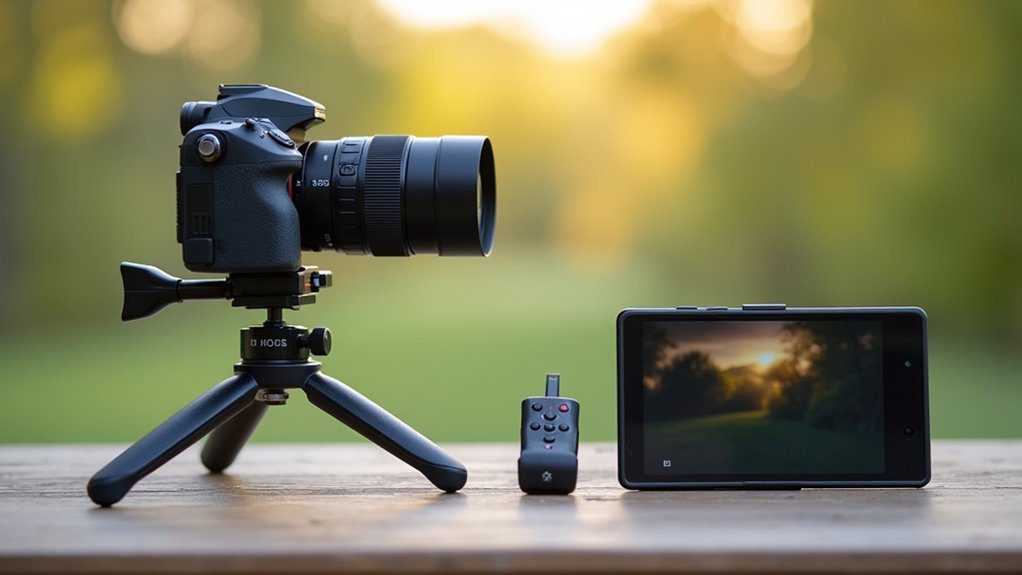
While photography offers a powerful means of creative expression, ALS patients face unique obstacles when pursuing this artistic outlet. As motor neurons deteriorate, you’ll experience increasing difficulty handling cameras, pressing buttons, and maintaining stability for clear shots.
The progressive nature of ALS means you might struggle with tasks requiring fine motor skills like adjusting settings or changing lenses. Even lightweight cameras can become burdensome as muscle strength diminishes. These physical limitations often coincide with the emotional challenge of adapting to new realities.
Despite these hurdles, photography remains valuable as both therapy and creative expression. Photographers like Anthony Carbajal demonstrate that with adaptive equipment, it’s possible to continue pursuing photography despite paralysis. The frustration of physical limitations can be offset by the psychological benefits of capturing meaningful moments and participating in an activity that connects you to the world around you.
Voice-Activated Camera Systems: A Hands-Free Solution
Voice-activated camera systems represent one of the most liberating technological advancements for photographers with ALS. These systems interpret spoken commands to operate your camera without physical interaction, giving you back creative control as mobility decreases.
You’ll find these systems increasingly compatible with smart home assistants like Alexa and Google Assistant, creating a seamless photography experience. The AI-driven interfaces can adapt to speech changes as your condition progresses, with many offering personalized voice model training. These systems can also be integrated with smart home devices that enhance your photography setup through remote control capabilities.
When combined with eye-tracking technology and AAC tools, you’ll maintain photography capabilities even as speech deteriorates.
These systems reduce fatigue while enabling spontaneous photo capture, helping you stay connected to creative expression and social documentation—ultimately improving your quality of life through continued artistic participation.
Eye-Tracking Photography: Capturing Moments With a Glance
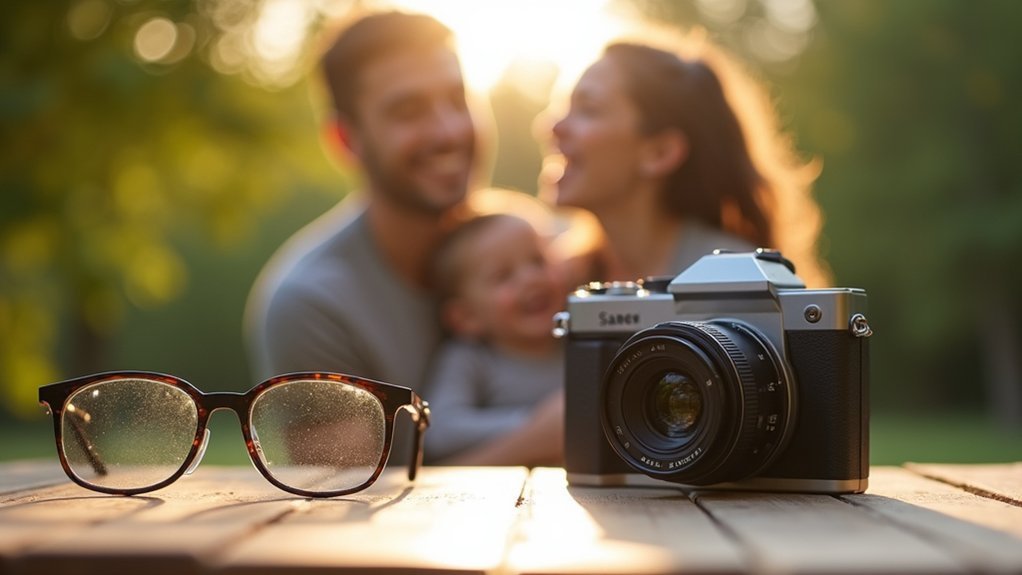
You’ll find remarkable freedom with gaze-controlled shutter systems that allow you to snap photos using just your eye movements.
These specialized camera interfaces track your glance patterns, enabling you to frame, focus, and capture images without physical manipulation of equipment. Similar to how the Eyegaze Edge® empowers ALS patients to communicate, these photography tools transform the creative experience for users with limited mobility.
The focus-free technology transforms visual storytelling for those with ALS, letting you document life’s meaningful moments through intentional looks rather than button presses.
Gaze-Controlled Shutter Systems
For people living with ALS who retain eye movement but have limited motor control, gaze-controlled shutter systems represent a revolutionary advancement in photography accessibility.
These devices track precisely where you’re looking, allowing you to capture photos with just your eyes. Most systems require minimal setup—often just 15 seconds for calibration. The technology analyzes eye movements 60 times per second to ensure precise control when taking photographs.
You’ll navigate through an intuitive interface with menu keys arranged for easy selection without any head movement. The technology works even in low light conditions and accommodates droopy eyelids, reducing fatigue during use.
Advanced software processes images multiple times per second, ensuring accurate tracking of your gaze. Beyond photography, you can use these systems to control your environment, browse the web, or communicate through text-to-speech.
While these tools may have a learning curve, they offer independence that’s truly invaluable.
Focus-Free Visual Storytelling
When traditional camera equipment becomes unmanageable due to ALS progression, eye-tracking photography opens entirely new possibilities for visual expression. You’ll capture images simply by looking at your subject—no hands, head movement, or physical controls needed.
Smartphone apps like EyePhone enable you to independently operate camera functions, reducing dependency on caregivers while preserving energy. These systems work effectively outdoors and in various lighting conditions thanks to anti-glare screens and specialized settings. Similar to how the Shuffle Speller provides communication options, these photography solutions help overcome limited mobility challenges.
The technology translates your natural eye movements into precise camera controls for framing, focusing, and triggering the shutter. You can immediately share these moments through integrated social media platforms, maintaining connections with loved ones.
This approach to photography supports emotional well-being by allowing creative expression despite physical limitations.
Mounting Options: Stabilizing Cameras for Limited Mobility
For photographers with ALS, you’ll find wheelchair camera mounts that securely attach to your mobility device while allowing adjustable positioning.
Hands-free triggering systems work alongside these mounts to let you capture images through breath control, eye movement, or voice commands.
Bed-mounted support arms offer similar stability when you’re resting, with flexible positioning that brings your camera exactly where you need it. When in bed, consider installing ALZO’s ceiling camera mounts that can be positioned directly above to capture overhead shots without requiring physical manipulation.
Wheelchair Camera Mounts
Securing a camera to your wheelchair transforms photography possibilities for those with ALS and limited mobility.
These specialized mounts clamp onto posts up to 2 inches thick and support cameras weighing up to 8 pounds—perfect for DSLRs and medium-sized equipment.
Built from heavy-duty metal materials, these mounts feature adjustable arms that you can bend and twist to achieve your desired angle.
You’ll appreciate the quick landscape-to-portrait orientation adjustments that don’t require holding the camera.
Users report high satisfaction with these mounts, praising their stability and ease of use.
The clamps adapt to various wheelchair designs, allowing you to move freely while maintaining camera stability. The ALZO Camera Flipper enables rapid 90-degree repositioning from landscape to portrait mode without removing your camera.
With a wheelchair camera mount, you’ll regain creative freedom to capture images from different perspectives despite mobility challenges.
Hands-Free Triggering Systems
Hands-free triggering systems expand photography possibilities beyond wheelchair mounts, enabling those with ALS to capture images without manual camera operation.
Motion detection technology automatically activates your camera when movement occurs, perfect for capturing spontaneous moments. Similar to how Philips Hue cameras can automatically trigger alarms upon detecting specific movement, these systems provide reliable operation without manual intervention.
Voice assistants provide simple control through spoken commands, while eye-tracking systems let you trigger shutters with just your gaze.
For those with some mobility, foot pedals and breath-controlled devices offer alternative triggering methods.
Bluetooth and RF technologies create wireless connections between your camera and triggering devices, eliminating the need for physical contact.
AI assistance enhances these systems by recognizing specific events or people, triggering shots at precisely the right moment.
Consider adaptive technologies designed specifically for different abilities, including capability switches that can be customized to your unique needs.
Bed-Mounted Support Arms
Bed-mounted support arms offer a game-changing solution for ALS photographers confined to bed for extended periods.
These articulating arms securely attach to your bed frame, providing a stable platform for your camera without requiring you to hold it, dramatically increasing your photographic independence.
The benefits of these versatile mounting systems include:
- Adjustable positioning – Multi-jointed arms allow you to capture images from various angles without moving yourself.
- Universal compatibility – Most arms accommodate different camera models using standard 1/4″-20 mounting bolts.
- Extended functionality – Beyond photography, these arms can hold tablets, e-readers, or other devices for various activities.
Installation is typically straightforward, though complex setups may require assistance. To achieve optimal height, you might need to incorporate bed risers just as they’re used to improve bed accessibility.
Once in place, you’ll enjoy newfound creative freedom despite mobility limitations.
Simplified Camera Controls for Progressive Motor Decline
As motor neurons deteriorate in ALS, individuals face mounting challenges with camera operation that once seemed effortless.
You’ll find that cameras with simplified modes and accessible menu systems can greatly reduce complexity during use.
Look for devices with voice-activated functions and remote shutter controls that eliminate the need for precise finger movements.
Voice commands and wireless triggers transform photography from a physical challenge into a seamless creative experience.
Cameras featuring large grip handles, tactile feedback buttons, and automated focus systems accommodate declining dexterity while maintaining creative control.
Consider models with advanced stabilization to compensate for tremors.
Remote viewing tools allow assistants to help frame your shots without taking over the creative process.
For longer photo sessions, choose lightweight cameras with extended battery life and easy-to-access memory card slots.
These adaptations make photography remain accessible as your motor skills change, especially important since fine motor tasks are typically the first abilities affected in hand ALS symptoms.
Smartphone Photography Adaptations for ALS
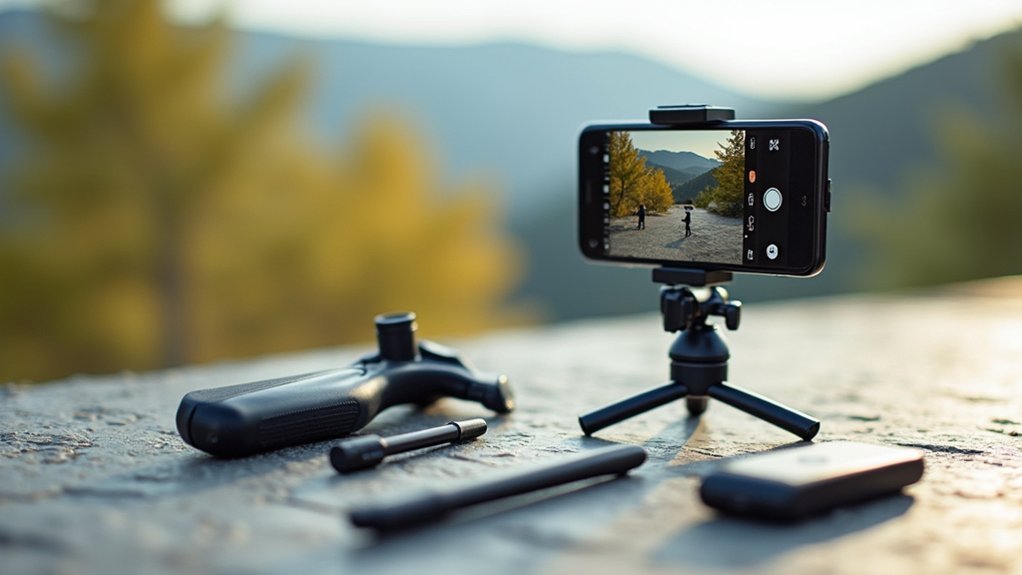
Smartphones have revolutionized photography access for people with ALS, offering touchscreen interfaces that require less physical strength than traditional cameras.
With integrated accessibility features and specialized apps, you’ll find photography more accessible as your condition progresses. The upcoming Mobile Device Photography Series provides hands-on instruction specifically designed for individuals living with ALS.
Eye-tracking technology shows particular promise, with apps like “EyePhone” allowing you to control your camera through eye movements alone.
These innovations work seamlessly with existing assistive devices you might already use.
Three key smartphone adaptations for ALS photography:
- Eye-tracking apps that let you frame, focus, and capture images using only eye movements
- AI-powered voice commands that control camera settings and timing
- Gaze-based interfaces that navigate photo editing and sharing functions
The ALS Association offers online workshops specifically designed to help you master these photography tools.
Remote Triggering Devices and Their Applications
Remote triggering devices offer powerful solutions for people with ALS who experience limited mobility but still want to pursue photography. These tools allow you to capture images without physically pressing the shutter button, giving you freedom and creative control.
With wireless connectivity, you can position cameras in unique locations and trigger them remotely. Many devices integrate with smartphone apps, enabling adjustments through accessible interfaces you’re already comfortable using. Products like the PocketWizard PlusXe Transceiver provide reliable wireless triggering at various distances for camera and flash control.
Features like sound, laser, and lightning detection modes help capture precise moments without requiring quick reflexes.
For sports or high-speed photography, these triggers excel with millisecond delay control and continuous shooting capabilities. You’ll also benefit from off-camera flash control for better lighting options.
When choosing a trigger, consider compatibility with your specific camera brand and look for TTL capability for automatic exposure control.
Integrating Photography With Existing Assistive Technologies
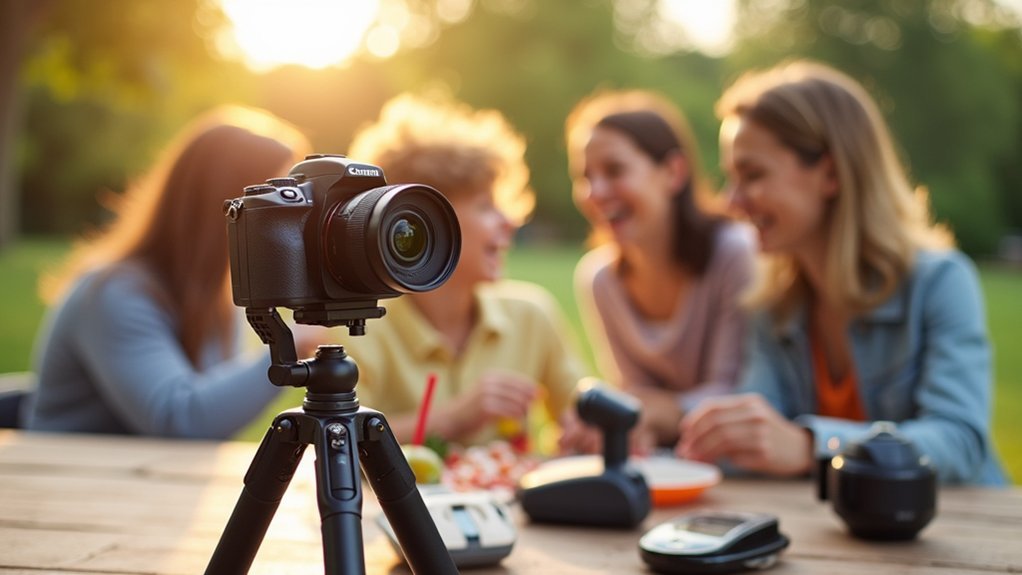
For photographers with ALS, integrating existing assistive technologies with camera equipment opens up remarkable possibilities that weren’t previously available.
You can leverage your daily assistive tools to enhance your photography experience without investing in completely new systems.
- Eye-tracking integration – Connect your existing eye gaze systems to control camera functions, allowing you to frame shots, adjust settings, and capture images using only eye movements.
- Environmental Control Systems (ECS) – Use your adapted switches or voice commands that already control your home environment to trigger camera functions remotely.
- AAC device compatibility – Your speech generating devices and communication systems can interface with photography apps, enabling you to edit, organize, and share your photos through the same interface you use for communication. Technologies like Cognixion’s brain-computer interfaces can provide additional hands-free options for more precise control over photography equipment.
Photovoice: Empowering ALS Patients Through Visual Storytelling
While assistive technologies enhance the technical aspects of photography, Photovoice takes this creative expression to a more profound level. This qualitative research tool empowers you to document your ALS journey through images that capture your unique perspective.
By participating in Photovoice, you’ll share your experiences with diagnosis, loss of function, and isolation while highlighting healthcare challenges you’ve faced. Your photographs become powerful storytelling vehicles that communicate what words alone cannot.
Through images, we voice what ALS silences—creating visual narratives of our journey beyond words.
Unlike traditional interviews, Photovoice offers you a platform for visual reflection and personal narrative. The process often bolsters hope—a critical coping mechanism when living with ALS. Research shows that maintaining a positive attitude is essential for effectively coping with the challenges of ALS.
Many clinics are exploring how to incorporate this participatory approach into regular care, recognizing its value in fostering resilience and combating isolation through creative expression.
Frequently Asked Questions
Can Insurance Cover Specialized Photography Equipment for ALS Patients?
You can get insurance for photography equipment, but there’s no ALS-specific coverage. You’ll need to explore general policies that cover your specialized gear and possibly seek customized options for your unique needs.
How Do Seasonal Weather Changes Affect Outdoor Photography Accessibility?
Seasonal weather affects your outdoor photography access considerably. You’ll find spring and fall most accommodating, while summer’s heat and winter’s cold create unique challenges for mobility, equipment operation, and shooting conditions.
Are There Photography Workshops Specifically Designed for ALS Patients?
Yes, you’ll find specialized photography workshops for ALS patients through organizations like The ALS Association. They’ve developed programs with adaptive technologies, online accessibility, and mobile device options to accommodate your changing mobility needs.
What Privacy Concerns Arise When Caregivers Assist With Photography?
When caregivers assist with photography, you’ll face privacy risks including unauthorized sharing, HIPAA violations, and boundary issues. You should require consent forms, establish clear limits for photos, and use facility-approved devices only.
Can Photography Therapy Improve Psychological Well-Being in ALS Patients?
Yes, photography therapy can greatly improve your psychological well-being as an ALS patient. You’ll experience enhanced emotional expression, reduced isolation, and increased hope through creative visual storytelling, as shown in photovoice research studies.
In Summary
You’re now equipped to capture life’s precious moments despite the challenges of ALS. With these accessible photography tools—from voice-activated cameras to eye-tracking systems—you’ll continue expressing yourself visually as your condition progresses. Don’t let physical limitations stop you from documenting your journey. Embrace these technologies to preserve memories, share your unique perspective, and maintain creative independence throughout your ALS experience.

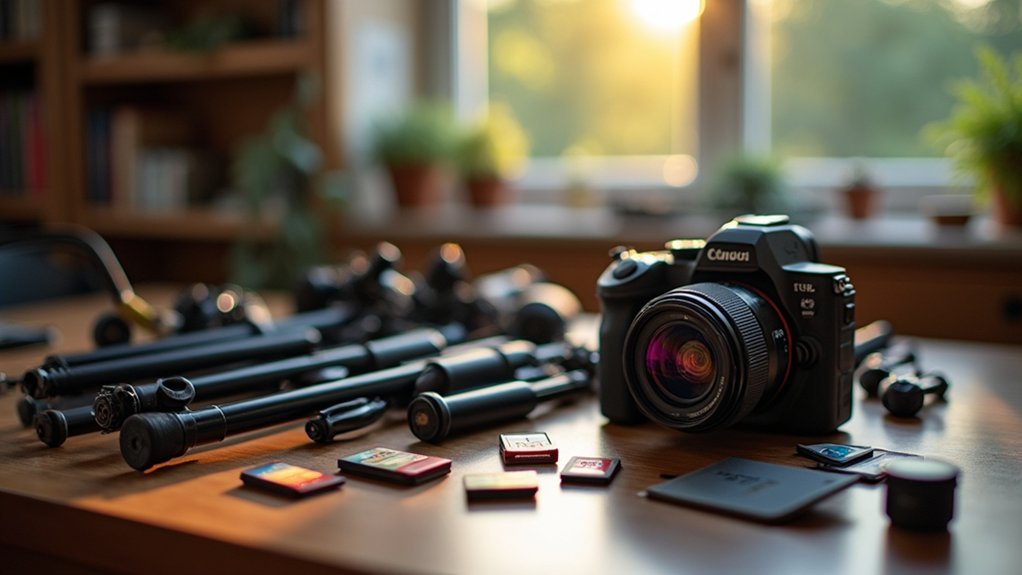



Leave a Reply